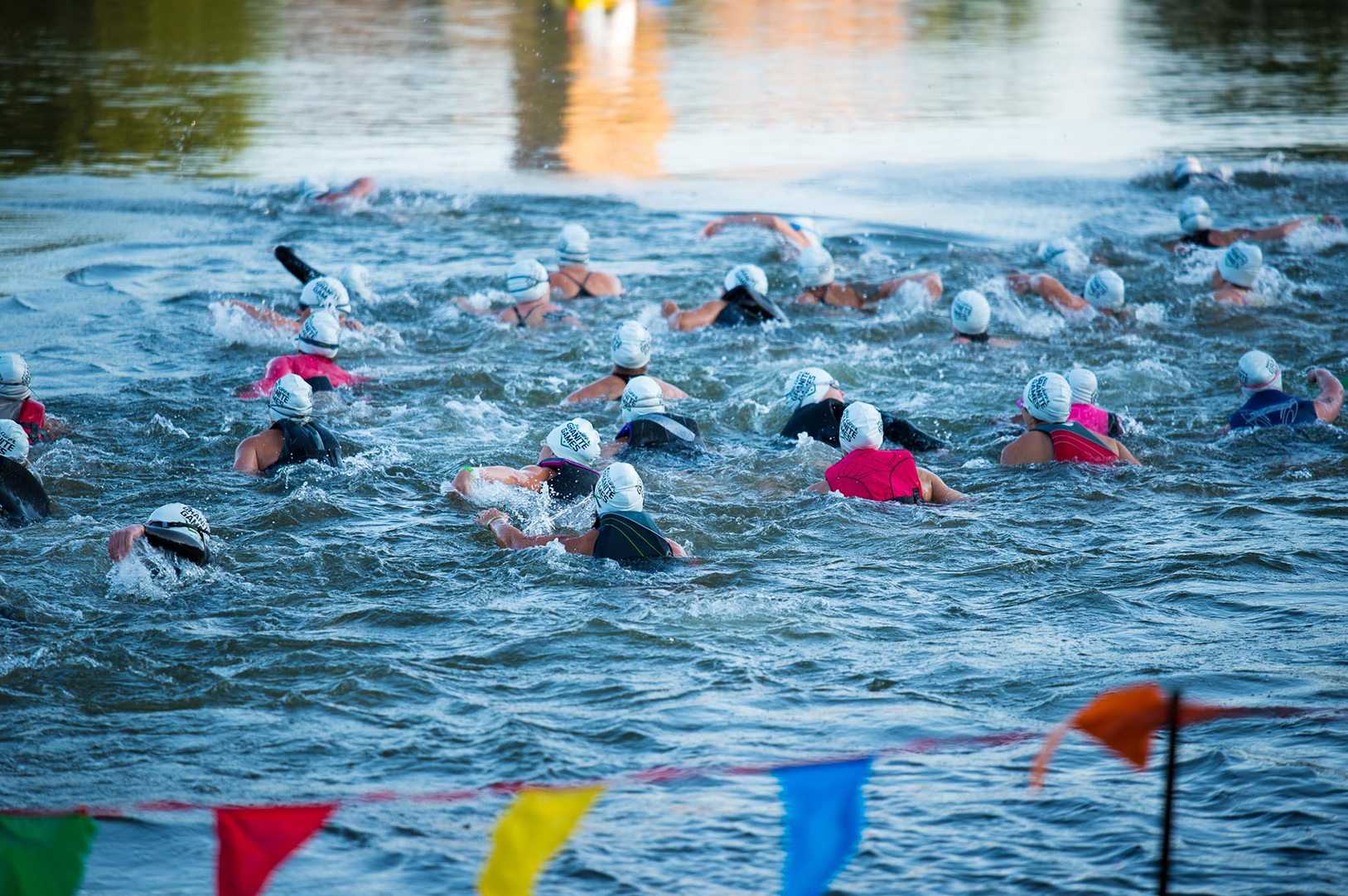The Swim Run is an event that was totally different from anything Granite Games has ever done. Technically off-site—although they were within running distance. How did you come up with this one? And when?
A lot of the big feature workouts, the events the year is remembered for, they’re actually written the year before. I actually have 2018’s feature workout already written. Normally, it’s something I really wanted to do in a previous year, but it didn’t fit the style of programming we were going for, or it didn’t make sense in that particular year, but it’s a really neat workout. So as I said, 2018 is already done. I know exactly what I want to do, and that has essentially always been the case since 2014. The swim event, that was something I wrote back in 2016, but it just didn’t fit for a couple different reasons. One of the things that held us back from doing it was the fact that 2016 was our first year on the football field. With that being the case, we wanted to ensure that venue ran well. Another element we really wanted to use in 2016 out on the field were the stadium stairs. Again, brand new venue, we didn’t want to push it too much so we held off on the stairs. And then what do you see? You see the stairs being used in 2017, and you see the Swim Run happen.
The Swim Run was something we’d been talking with the city about. It wasn’t easy or simple to get the Swim Run planned, it took a lot of logistics and working very closely with the St Cloud Police Department. They were more than excellent—they were a blessing to work with. And the city of St Cloud was great, and of course St Cloud State Park & Rec. There were so many moving pieces behind this one. For example, the pure logistics of bringing 2200 people via bus to a completely different location—and ensuring that system functioned—were daunting.
Plus you had to chip the athletes.
Right, chipping was new. Making sure that was functional was another layer of complexity. But to answer the question of where the Swim Run came from, that event was written approximately 15 months before it happened. We have a vault of workouts, and our policy is we’re not going to force something if it doesn’t make sense. We’ll wait. Often, I’ll write the entire year around one event. And this year, it was written around the Swim Run.
For example, we knew we wanted to open up with something really heavy directly after the Swim Run. We knew swimming would make Athletes’ legs a lot heavier than they expected, and we kept the run very short so there was no hiding. And on top of it all, they had a fast turnaround, after which they had to do a very heavy—and still technical—clean workout.
To answer your initial question, this event was conceived months and months beforehand. And actually, the initial answer [from the city] was, “No, you guys can’t do it.” Just because it was so many Athletes. Eventually, we got it approved for the Pro Division, 60 individuals. Then, I looked at it and said, “You know what? If this is going to be the pinnacle event this year, I think it would be unjust not to let every Athlete experience it.”
It was certainly a highlight of the weekend for many Athletes, and an event that pushed people outside their comfort zone—folks who maybe weren’t proficient swimmers or swimmers at all prior. And now they’ve returned home and they’re practicing their swimming still because you’ve introduced them to a new skill and they’re proud of that.
We tried to be smart with it. We gave 65-day notice; the swim cap was posted 65 days out exactly. I wasn’t trying to hide the fact of what we were going to do. When you’re playing with people’s lives in this fashion, you’ve got to be smart, you’ve got to be sensible. When we knew we were going to swim, we were aware a lot of people are likely from the north region and probably don’t swim as much. Down south at Wodapalooza, I think they’ve swam every year, so if you go to that competition, you know you’re going to swim. If you go to the Granite Games, you don’t ever think swimming. And for us, I felt it was important in our first year doing a swim to notify them ahead of time.
One of the things I’m most proud of, from an Athlete stance and also from our lifeguards, is that we rescued .5%. That’s 10 Athletes we pulled out. And of those 10, not one said they were saved for a medical purpose. They simply were in the water, swam to a lifeguard and asked to be brought back. For me, that was a huge fear when you put that many Athletes in the water. I think the ability to use a life jacket was smart.
Wetsuits were a last minute change to the rules, and life jackets being allowed created a bit of a stir. Talk about those choices.
We looked at water temperatures leading up to the event. With the unusually cold temperatures that hit here in August, which is usually our hottest month, water temps started to drop. So we wanted to be safe by allowing wetsuits.Now life jackets—we’ve received some flack that we should have penalized Athletes for wearing them. My thought, and I hope Athletes read this, is that 1) It was fair for everybody. Everyone had the opportunity to wear a life jacket. I look at it as on par with allowing Oly shoes or lifting belts. It’s fair for everyone, the option was available to all. When you’re playing with people’s lives and asking them to do an event in which there’s a high risk for something catastrophic to happen, you should always put the Athlete’s safety first. By adding a penalty, you’re going to put ego into play. And once ego is in play, some Athletes are going to say, “You know what? I’m just going to do it. I gotta do it for my team, I can’t take that time penalty.”
We knew all those things. We knew people would likely not wear a life jacket if we added a time penalty. And I would take Athletes swimming faster in a life jacket over having somebody getting pulled out of the water. So I’m very proud we only had to take 10 Athletes out of the water, that’s great. That means everybody else finished. And for us, I think we had to be smart with it. Adding a penalty for ensuring an Athlete stays alive—would it have been better for the actual scoring of the event? Absolutely. But there’s a far greater risk hanging in the balance of something actually happening, so that’s why we chose both to use life jackets and not penalize Athletes for wearing one.
How nervous were you when the temps were dipping in the week or two leading up to the event? Was there a cut-off where you would have called off the Swim?
The coldest the water ever got down to was 71 degrees. So, if you’re a Minnesotan, that’s warm for us. What was intriguing about the day was the Athletes who swam in the morning said the water felt extremely warm. And the Athletes who swam in the afternoon said the water felt colder. And of course that’s all due to the air temperature. If your heat was one of the later ones of the day, hopping in the water from the warm air meant that swim felt a bit chilly. At 70-ish degrees, no it wasn’t super warm, but it was doable. I think the Athletes from down south probably enjoyed wearing a wetsuit and a lot of the northern Athletes were in standard bathing suits.
This is the very first event in which everyone was in a position to compare themselves across all divisions. What are your thoughts on that?
It’s kind of a neat thing. This is the first event we’ve ever done where everyone did the same exact thing. And it’s such a wild card. There was no need to cut it down for any of the divisions, and I think it was fun to just let everybody go. I’m curious to know who the top female was, who the top male was, to see how those numbers shook out.
It was cool to see everything come together. The logistics behind the event involved a team of 20 people who worked around the clock, both onsite and off, and that was their whole thing. Staging the athletes, transporting them, beautifying the beaches, bringing in fresh sand, clearing rocks and debris…
Would you do it again?
Maybe. Maybe we will, maybe we won’t. I don’t know. But I’m happy with how it went. It’s sort of this milestone after which Athletes truly need to be prepared for anything with us.
We’d love to know if you think you can top this in 2018 but since you already know what you’re going to do, maybe you’ve already figured that worry out.
I had a close friend who saw the Trail Run, the Hill Run, and then the Swim Run, and they said to me, “You left it all out there for 2017. You’re not going to have anything fun to follow with in 2018.” To this day, I still look back on the Minnesota Triathlon as one of the great uses of the equipment and space we had in front of us, and I think each year, that’s the fun test put to me. Can I create something that’s new and fun for the Athletes. Everything from the stairs this year—which were grueling—to the Minnesota Triathlon to the Sprint Tri to the Trail Run and the Swim Run. I think that will be the challenge next year is to do something that the Athletes wouldn’t have thought of. Look at the sandbag from 2016. That caught a lot of Athletes’ attention. And then we brought it back, but we did it differently. That was always the intention. That’s the fun of the event, to write new workouts that are smart in design but fresh as well.



